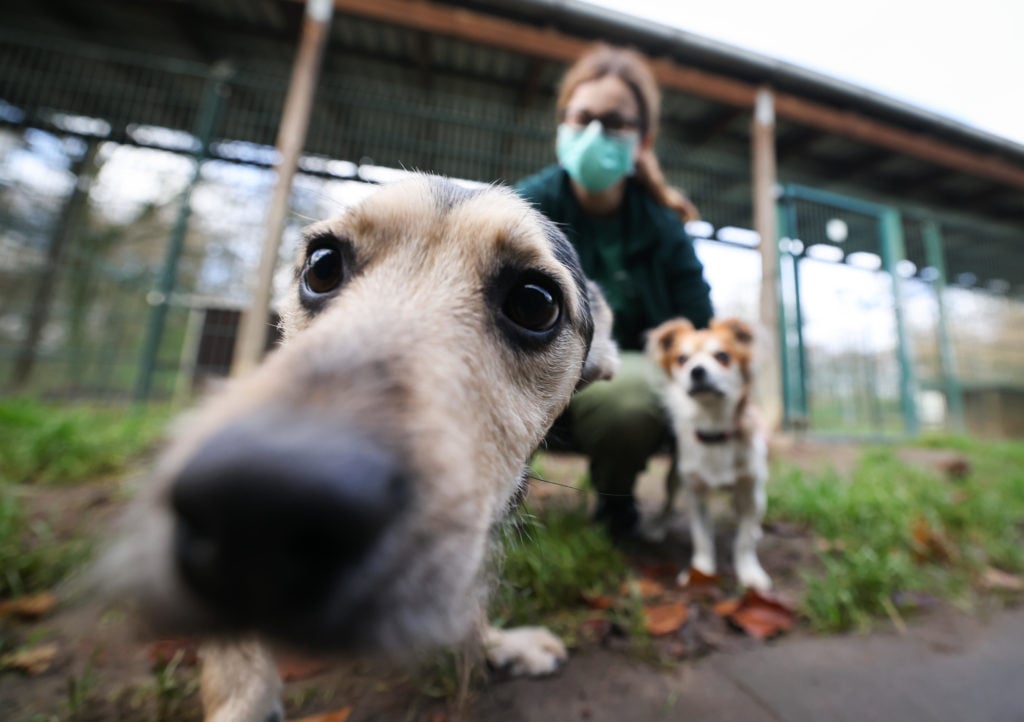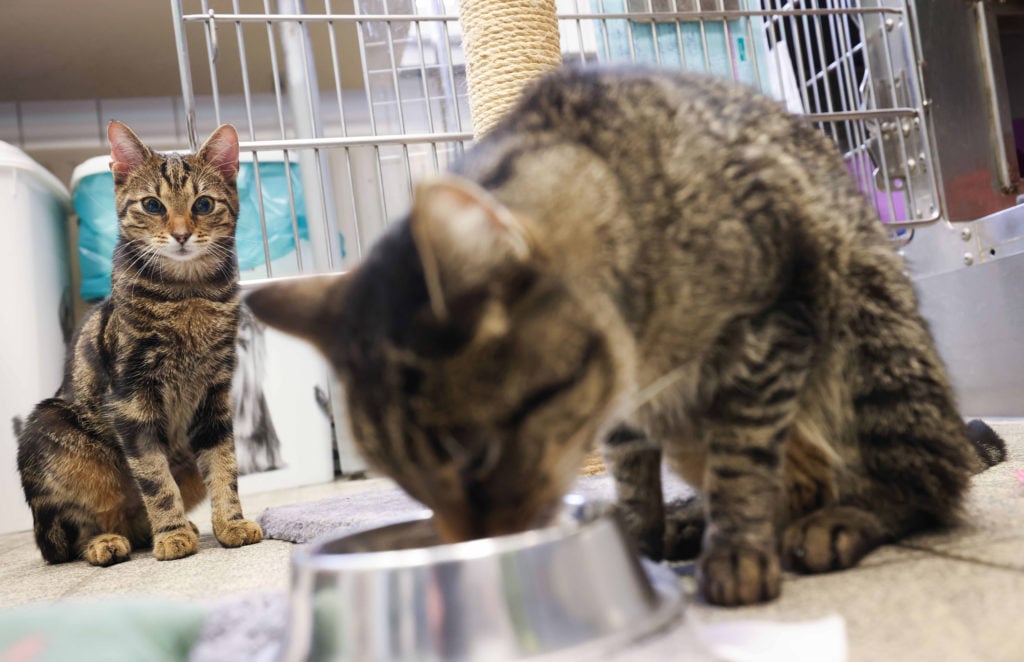EXPLAINED: How to adopt a pet in Germany

Desperate for a furry addition to the family but unsure about the process of adopting in Germany? Never fear - it's not as hard as you may think. Here's a breakdown of what to expect.
It's no secret that Germany is a nation of pet lovers. In 2020, there were almost 16 million cats and 11 million dogs living in households in Germany - not to mention five million small animals like rabbits, hamsters and guinea pigs, and some more esoteric pets.
Interestingly, the default when finding a pet in Germany is to go straight to a rescue centre. Though you can find breeders for specific breeds of dog and cat, most people much prefer to spare the expense and help an animal in need instead.
For that reason, you can find all sorts of shelters, from small charities to massive organisations that are spread across several acres of land. Tierheim Berlin, which boasts the proud title of being Europe's largest animal shelter, is one such organisation.
Since Covid, these charitable organisations have been overwhelmed by pets that have been returned after being adopted on a whim during the first few lockdowns. In that sense, there's never been a better time to find the perfect pet.
READ ALSO: Furry friends help Germans ease pandemic blues
So, if you've decided to do things the German way and adopt of a cat, dog or even a lizard of your own, here's how to go about it.
Step One: Find a shelter
When it comes to finding a shelter near you, Google is definitely your best friend. Type in the name of your town and either Tierschutzverein (animal protection agency) or Tierheim (animal shelter / rescue home) and see what comes up. Most of these will be larger shelters that offer a range of different types of animals, from rats to Rottweilers, so it's worth going on their websites and having a browse.
Alternatively, you can narrow down your search further by, say, cats or dogs, by typing in Katzenschutzverein or Hundeschutzverein. If you're looking for a specific breed and want to adopt rather than buy, searching for the breed with the words "in Not" (in distress/need) or "Hilfe" (aid) may help you find charities dedicated to rescuing and rehoming that breed. A quick tip, however: not all breeds are called the same thing in English as they are in German, so you may want to run the name of your breed through a reliable translator before you start your search.

Milo und Julius play with their carer at an animal shelter in Hamburg. Photo: picture alliance/dpa | Christian Charisius
Step Two: Find a pet
Once you've found some rescue centres in your area, you can start looking for an animal that you'd like to give a forever home to. It's worth mentioning that this isn't just like online shopping: shelters are looking for people that will fit the needs of their animals in terms of their lifestyle, housing and family arrangements, working schedule, experience and more.
For this reason, you can save time by looking very closely at the descriptions of each of the animals included on the website. In particular, look out for:
- Specifications on what kind of property you should have
For cats, it's very common to read that access to outdoor space is required - unless, of course, the cat is very elderly, unwell or otherwise used to being indoors. So if you see phrases like "Freigang benötigt" (outside access required), the cat probably won't be well-suited to living in an apartment building. Alternatively, an indoor cat might be happy with a "gesicherter Balkon", meaning you would need to have a net installed on your balcony.
Other requirements for housing might include being on the ground floor (Ebenerdig), which is quite common for elderly dogs with hip or joint problems. The shelter might also prefer you to have a house with a garden or a roomy flat for a larger animal. You may also see requests for people who live in a quiet area (ruhige Umgebung), suburbs or the countryside (auf dem Land / in einer ländliche Umgebung).
If you're renting, you'll also need to ensure you have permission to keep pets in the property.
READ ALSO: Renting in Germany: What you need to know about keeping pets

A cat looks out of its cage at Ludwigshafen Tierheim in Rhineland-Palatinate. Photo: picture alliance/dpa | Uwe Anspach
- Guidance on who should be in the house
Not all animals get on well with other pets, or even with children, so it's important to check the description of each animal closely to see whether they are suitable for your household. Some pets may prefer to move into a house with another pet companion, or some may just prefer a quiet home with a single person or couple. Look out for phrases like: "gut verstehen" (to get on well with) or "vertragen" (to tolerate) as clues to whether your new pet will be good with other animals or young children in the house.
It's not uncommon for animal shelters to ask for people with a quiet and regular routine or people (like retirees) who will have a lot of spare time for their new pet, so that's also something to be aware of.
- Personality traits and experience
Of course, a crucial thing to find out is what kind of personality each animal has, such as whether it's had traumatic experiences in the past and how it relates to people. With dogs, crucial factors to consider are whether your new canine friend has learned any of the basic commands (Grundkommandos), whether it can travel in cars and on public transport, and how long it can be left alone for. Some animals may also have health issues and require medication.
Since even non-traumatised dogs can require a lot of patience and understanding, you'll probably see animal shelters state a preference for "Hundeerfahrene Menschen" (experienced dog owners) or "Rassenerfahrene Menschen" (people with experience of that breed) quite often. If you're a complete beginner, you may get lucky and find the golden worlds: "für Anfänger geignet" (suitable for beginners), which is your cue to get on the phone right away.
READ ALSO: What Americans need to know about bringing their pets to Europe
Step Three: Arrange a visit
If you've found a potential pet that looks perfectly suited to your circumstances, the next step is to drop the animal shelter an email or call to express your interest and try and arrange a visit.
If you send a message, be sure to mention what makes you suitable - are you at home a lot as a freelancer, do you have a big house and garden, or do you have experience with that particular breed of cat or dog? If the shelter is inundated with enquiries, this sort of thing could help you stand out from the crowd.

A rabbit waits for its forever-home at a shelter in Kassel, Hesse. Photo: picture alliance/dpa | Swen Pförtner
Though Covid rules have eased up a lot in Germany in the previous months, shelters may still have their own restrictions in place, so check on their website to see what their visiting policy is. Once you know all of that, you should be able to arrange a suitable to come and meet one or two of the animals.
Don't necessarily expect to go there and come back with a new pet the same day. With dogs and cats in particular, the shelter may request two or three visits - or even several - to build a good relationship with the animal first. Which brings us to our next point...
Step Four: Prove your suitability
As we've mentioned, adopting a pet in Germany isn't just about picking up the cutest pup or kitty in the shelter. You should expect a house visit so that the rescue centre can assess whether your living space would be safe and spacious enough for your animal. If you need to secure your balcony for a cat, for example, you'll probably need to do this beforehand so that they can see you have the right up set-up in your apartment.
Along with assessments of your house or flat, you may be asked questions about your working habits, living arrangements, plans for the future and experience with previous pets. This is to ensure that your lifestyle will be a good fit for your new pet and to minimise the chance of you having to give the animal back in the future.
If everything fits, the last hurdle is pay a small adoption fee, which will vary from shelter to shelter, and take your new pet home.
What else should I know?
You may feel like there are financial barriers to adopting a pet, but the biggest and most well-funded animal shelters in Germany try to make this less of an issue. Tierheim Berlin, for example, generally covers the cost of medication and medical treatment for elderly animals that are adopted, and you can also get free food for the animal if you pick it up yourself.
Another thing to understand is that, even if it doesn't look like it, there may be a suitable animal at the shelter for you. Very old cats, for example, are sometimes not listed on websites but are well suited to small living spaces where they can relax and sleep all day. The best way to find out is to build a relationship with the shelter and show that you're a reliable and dedicated person. Once they know your circumstances, they may recommend an animal they think would be happy to live with you - so don't give up right away just because you don't live in a sprawling ranch in the countryside.

European shorthair cats Jonas und Hubi at a shelter in Hamburg. Photo: picture alliance/dpa | Christian Charisius
If you're getting a dog, remember that you will need to register it at your local Bürgeramt and that it will also be subject to "dog tax" (Hundesteuer). The amount of this tax varies from state to state, and could be anywhere from €90 in Hamburg to €186 in Rhineland-Palatinate. The aim of this tax is to prevent people getting too many dogs, so the amount goes up for every additional dog you get. Some states provide relief from dog tax if you get your dog from a rescue home. In Berlin, for example, you won't have to pay dog tax for the first five years.
In some states, you will also have to take out personal liability insurance in case your pet harms anything or anyone. In North Rhine-Westphalia, this applies to anyone with an animal larger than 40cm. You may also want to take out pet insurance for any unforeseen costs.
READ ALSO:
Comments (1)
See Also
It's no secret that Germany is a nation of pet lovers. In 2020, there were almost 16 million cats and 11 million dogs living in households in Germany - not to mention five million small animals like rabbits, hamsters and guinea pigs, and some more esoteric pets.
Interestingly, the default when finding a pet in Germany is to go straight to a rescue centre. Though you can find breeders for specific breeds of dog and cat, most people much prefer to spare the expense and help an animal in need instead.
For that reason, you can find all sorts of shelters, from small charities to massive organisations that are spread across several acres of land. Tierheim Berlin, which boasts the proud title of being Europe's largest animal shelter, is one such organisation.
Since Covid, these charitable organisations have been overwhelmed by pets that have been returned after being adopted on a whim during the first few lockdowns. In that sense, there's never been a better time to find the perfect pet.
READ ALSO: Furry friends help Germans ease pandemic blues
So, if you've decided to do things the German way and adopt of a cat, dog or even a lizard of your own, here's how to go about it.
Step One: Find a shelter
When it comes to finding a shelter near you, Google is definitely your best friend. Type in the name of your town and either Tierschutzverein (animal protection agency) or Tierheim (animal shelter / rescue home) and see what comes up. Most of these will be larger shelters that offer a range of different types of animals, from rats to Rottweilers, so it's worth going on their websites and having a browse.
Alternatively, you can narrow down your search further by, say, cats or dogs, by typing in Katzenschutzverein or Hundeschutzverein. If you're looking for a specific breed and want to adopt rather than buy, searching for the breed with the words "in Not" (in distress/need) or "Hilfe" (aid) may help you find charities dedicated to rescuing and rehoming that breed. A quick tip, however: not all breeds are called the same thing in English as they are in German, so you may want to run the name of your breed through a reliable translator before you start your search.

Step Two: Find a pet
Once you've found some rescue centres in your area, you can start looking for an animal that you'd like to give a forever home to. It's worth mentioning that this isn't just like online shopping: shelters are looking for people that will fit the needs of their animals in terms of their lifestyle, housing and family arrangements, working schedule, experience and more.
For this reason, you can save time by looking very closely at the descriptions of each of the animals included on the website. In particular, look out for:
- Specifications on what kind of property you should have
For cats, it's very common to read that access to outdoor space is required - unless, of course, the cat is very elderly, unwell or otherwise used to being indoors. So if you see phrases like "Freigang benötigt" (outside access required), the cat probably won't be well-suited to living in an apartment building. Alternatively, an indoor cat might be happy with a "gesicherter Balkon", meaning you would need to have a net installed on your balcony.
Other requirements for housing might include being on the ground floor (Ebenerdig), which is quite common for elderly dogs with hip or joint problems. The shelter might also prefer you to have a house with a garden or a roomy flat for a larger animal. You may also see requests for people who live in a quiet area (ruhige Umgebung), suburbs or the countryside (auf dem Land / in einer ländliche Umgebung).
If you're renting, you'll also need to ensure you have permission to keep pets in the property.
READ ALSO: Renting in Germany: What you need to know about keeping pets

- Guidance on who should be in the house
Not all animals get on well with other pets, or even with children, so it's important to check the description of each animal closely to see whether they are suitable for your household. Some pets may prefer to move into a house with another pet companion, or some may just prefer a quiet home with a single person or couple. Look out for phrases like: "gut verstehen" (to get on well with) or "vertragen" (to tolerate) as clues to whether your new pet will be good with other animals or young children in the house.
It's not uncommon for animal shelters to ask for people with a quiet and regular routine or people (like retirees) who will have a lot of spare time for their new pet, so that's also something to be aware of.
- Personality traits and experience
Of course, a crucial thing to find out is what kind of personality each animal has, such as whether it's had traumatic experiences in the past and how it relates to people. With dogs, crucial factors to consider are whether your new canine friend has learned any of the basic commands (Grundkommandos), whether it can travel in cars and on public transport, and how long it can be left alone for. Some animals may also have health issues and require medication.
Since even non-traumatised dogs can require a lot of patience and understanding, you'll probably see animal shelters state a preference for "Hundeerfahrene Menschen" (experienced dog owners) or "Rassenerfahrene Menschen" (people with experience of that breed) quite often. If you're a complete beginner, you may get lucky and find the golden worlds: "für Anfänger geignet" (suitable for beginners), which is your cue to get on the phone right away.
READ ALSO: What Americans need to know about bringing their pets to Europe
Step Three: Arrange a visit
If you've found a potential pet that looks perfectly suited to your circumstances, the next step is to drop the animal shelter an email or call to express your interest and try and arrange a visit.
If you send a message, be sure to mention what makes you suitable - are you at home a lot as a freelancer, do you have a big house and garden, or do you have experience with that particular breed of cat or dog? If the shelter is inundated with enquiries, this sort of thing could help you stand out from the crowd.

Though Covid rules have eased up a lot in Germany in the previous months, shelters may still have their own restrictions in place, so check on their website to see what their visiting policy is. Once you know all of that, you should be able to arrange a suitable to come and meet one or two of the animals.
Don't necessarily expect to go there and come back with a new pet the same day. With dogs and cats in particular, the shelter may request two or three visits - or even several - to build a good relationship with the animal first. Which brings us to our next point...
Step Four: Prove your suitability
As we've mentioned, adopting a pet in Germany isn't just about picking up the cutest pup or kitty in the shelter. You should expect a house visit so that the rescue centre can assess whether your living space would be safe and spacious enough for your animal. If you need to secure your balcony for a cat, for example, you'll probably need to do this beforehand so that they can see you have the right up set-up in your apartment.
Along with assessments of your house or flat, you may be asked questions about your working habits, living arrangements, plans for the future and experience with previous pets. This is to ensure that your lifestyle will be a good fit for your new pet and to minimise the chance of you having to give the animal back in the future.
If everything fits, the last hurdle is pay a small adoption fee, which will vary from shelter to shelter, and take your new pet home.
What else should I know?
You may feel like there are financial barriers to adopting a pet, but the biggest and most well-funded animal shelters in Germany try to make this less of an issue. Tierheim Berlin, for example, generally covers the cost of medication and medical treatment for elderly animals that are adopted, and you can also get free food for the animal if you pick it up yourself.
Another thing to understand is that, even if it doesn't look like it, there may be a suitable animal at the shelter for you. Very old cats, for example, are sometimes not listed on websites but are well suited to small living spaces where they can relax and sleep all day. The best way to find out is to build a relationship with the shelter and show that you're a reliable and dedicated person. Once they know your circumstances, they may recommend an animal they think would be happy to live with you - so don't give up right away just because you don't live in a sprawling ranch in the countryside.

If you're getting a dog, remember that you will need to register it at your local Bürgeramt and that it will also be subject to "dog tax" (Hundesteuer). The amount of this tax varies from state to state, and could be anywhere from €90 in Hamburg to €186 in Rhineland-Palatinate. The aim of this tax is to prevent people getting too many dogs, so the amount goes up for every additional dog you get. Some states provide relief from dog tax if you get your dog from a rescue home. In Berlin, for example, you won't have to pay dog tax for the first five years.
In some states, you will also have to take out personal liability insurance in case your pet harms anything or anyone. In North Rhine-Westphalia, this applies to anyone with an animal larger than 40cm. You may also want to take out pet insurance for any unforeseen costs.
READ ALSO:
Join the conversation in our comments section below. Share your own views and experience and if you have a question or suggestion for our journalists then email us at [email protected].
Please keep comments civil, constructive and on topic – and make sure to read our terms of use before getting involved.
Please log in here to leave a comment.